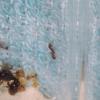- Formiculture.com
- Forums
- Gallery
- Members
- Member Map
- Chat

Need an ID - Florida ant
Started By
LIExotics
, Apr 20 2023 7:22 PM
7 replies to this topic
#1
 Offline
-
Posted April 20 2023 - 7:22 PM
Offline
-
Posted April 20 2023 - 7:22 PM
Hey everyone. So I found this ant when I was in Florida last year. My sister down there has been watching it for almost a year now. And this gorgeous queen just finally started laying eggs. I wasn't even sure if she was fertile. I'm assuming it is a semi-claustrial because my sister has been putting a drop of honey every other week, because at one point it was looking a little lethargic. So, now that she's started laying eggs, I would like a positive identity of this queen. She's about 3/8th of an inch long, so decently large. And I found her on the wall of a gas station we stopped at near Orlando. Thanks in advance everyone: here's the pics: https://imgur.com/gallery/kcGtmwc
#2
 Offline
-
Posted April 20 2023 - 7:48 PM
Offline
-
Posted April 20 2023 - 7:48 PM
#3
 Offline
-
Posted April 20 2023 - 7:48 PM
Offline
-
Posted April 20 2023 - 7:48 PM
Its an aphaenogaster species of some kind. These guys are actually fully claustral so no feeding is required.
My journals:
Polyergus Mexicanus: https://www.formicul...gs/#entry175528
Lasius minutus: https://www.formicul...cs/#entry174811
Lasius latipes: https://www.formicul...gs/#entry206449
General acanthomyops journal: https://www.formicul...yops-with-eggs/
Polyergus Mexicanus: https://www.formicul...gs/#entry175528
Lasius minutus: https://www.formicul...cs/#entry174811
Lasius latipes: https://www.formicul...gs/#entry206449
General acanthomyops journal: https://www.formicul...yops-with-eggs/
#4
 Offline
-
Posted April 20 2023 - 7:51 PM
Offline
-
Posted April 20 2023 - 7:51 PM
I figured it was an aphaenogaster, but couldn't tell what kind. And the fact that my sister said she got very lethargic, so I assumed she was weak, and told her to drop some honey in there, and the fact that she's been eating the honey like crazy, all confused me a bit. Plus I wasn't able to find an aphaenogaster species that looked exactly like her. She's more like a matte color then shiny like most aphaenogaster. Thanks guys.
#5
 Offline
-
Posted April 20 2023 - 7:57 PM
Offline
-
Posted April 20 2023 - 7:57 PM
How would I go about determining exactly what species of aphaenogaster she is? Wait until the eggs turn to nanitics? And is it normal for an aphaenogaster queen to go almost a full year before laying eggs??
#6
 Online
-
Posted April 21 2023 - 2:23 AM
Online
-
Posted April 21 2023 - 2:23 AM
I think I can see the lobes at the base of the antennae that would indicate she is Aphaenogaster treatae. It is not normal that she took so long to lay eggs, though.
"The ants are a people not strong, yet they prepare their meat in the summer." Prov. 30:25
Keep ordinary ants in extraordinary ways.
Keep ordinary ants in extraordinary ways.
#7
 Offline
-
Posted April 21 2023 - 11:35 AM
Offline
-
Posted April 21 2023 - 11:35 AM
Thank you. I appreciate it. I looked it up and it does look very similar.
#8
 Offline
-
Posted May 3 2023 - 11:05 AM
Offline
-
Posted May 3 2023 - 11:05 AM
More photos showing the antennal lobes would probably help--it is either A. treatae or ashmeadi. In eastern Florida (most of the peninsula) ashmeadi is fully black but in the panhandle they're about the same color as treatae. It's hard to tell how large the antennal lobes are compared to the rest of the scapes in these photos, and that is ultimately the determining factor. If you found out outside of the panhandle then treatae is highly likely anyway.
- OiledOlives likes this
0 user(s) are reading this topic
0 members, 0 guests, 0 anonymous users


















